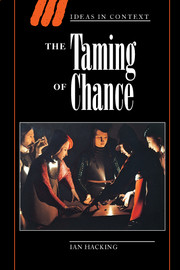Book contents
- Frontmatter
- Contents
- Acknowledgements
- 1 The argument
- 2 The doctrine of necessity
- 3 Public amateurs, secret bureaucrats
- 4 Bureaux
- 5 The sweet despotism of reason
- 6 The quantum of sickness
- 7 The granary of science
- 8 Suicide is a kind of madness
- 9 The experimental basis of the philosophy of legislation
- 10 Facts without authenticity, without detail, without control, and without value
- 11 By what majority?
- 12 The law of large numbers
- 13 Regimental chests
- 14 Society prepares the crimes
- 15 The astronomical conception of society
- 16 The mineralogical conception of society
- 17 The most ancient nobility
- 18 Cassirer's thesis
- 19 The normal state
- 20 As real as cosmic forces
- 21 The autonomy of statistical law
- 22 A chapter from Prussian statistics
- 23 A universe of chance
- Notes
- Index
- Ideas in Context
11 - By what majority?
Published online by Cambridge University Press: 05 June 2014
- Frontmatter
- Contents
- Acknowledgements
- 1 The argument
- 2 The doctrine of necessity
- 3 Public amateurs, secret bureaucrats
- 4 Bureaux
- 5 The sweet despotism of reason
- 6 The quantum of sickness
- 7 The granary of science
- 8 Suicide is a kind of madness
- 9 The experimental basis of the philosophy of legislation
- 10 Facts without authenticity, without detail, without control, and without value
- 11 By what majority?
- 12 The law of large numbers
- 13 Regimental chests
- 14 Society prepares the crimes
- 15 The astronomical conception of society
- 16 The mineralogical conception of society
- 17 The most ancient nobility
- 18 Cassirer's thesis
- 19 The normal state
- 20 As real as cosmic forces
- 21 The autonomy of statistical law
- 22 A chapter from Prussian statistics
- 23 A universe of chance
- Notes
- Index
- Ideas in Context
Summary
Paris, 14 August 1835 Gentlemen, what do you think is the probability of a jury decision, in which the majority is seven against five? Without a doubt, you will be shocked at the result. You will find that the probability of error is about one in four.
Oh! Oh! Laughter from the left
I shall assert that in a large number of jury decisions, given by a majority of eight to four, an eighth are marred by error – of eight who mount the scaffold, there is on average one who is innocent.
Loud denials from the centre. Long agitation
Such, gentlemen, are the results furnished by the calculus of probabilities, and provide the data needed to resolve our question.
Renewed agitation … the speaker is interrupted … private conversations break out on every bench
Here is a way in which the new statistics seemed to matter. In 1785 Condorcet applied probability theory to judicial questions. In 1815 Laplace made some powerful a priori deductions about conviction rates. Once judicial statistics were available, his protégé Poisson used statistical inferences to overturn his conclusions. There is then a simple three-stage story of probability arithmetic and the French jury. To repeat:
1785: no jury, no experience, no data. Condorcet deduced that the optimum twelve man jury will be one that can convict with a majority of ten or more members. But he preferred a jury of 30. […]
- Type
- Chapter
- Information
- The Taming of Chance , pp. 87 - 94Publisher: Cambridge University PressPrint publication year: 1990



